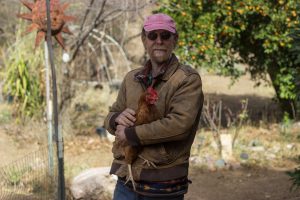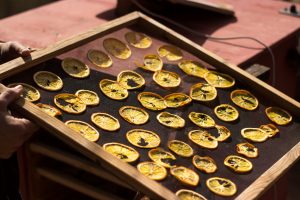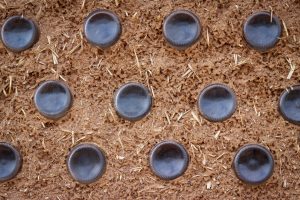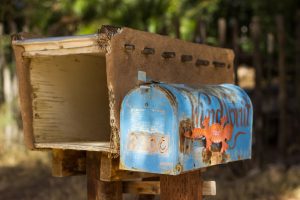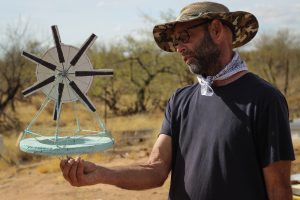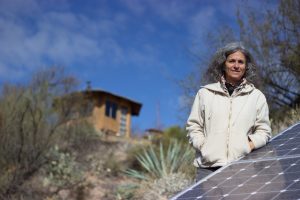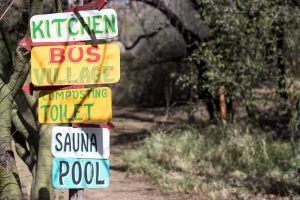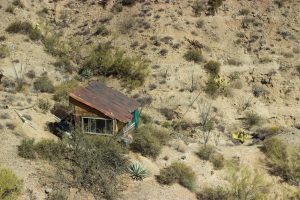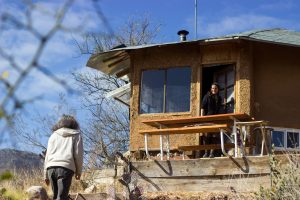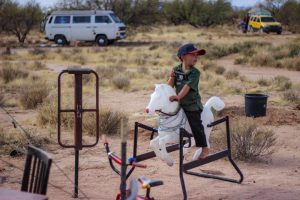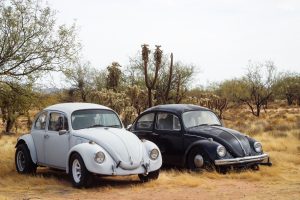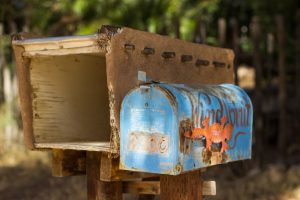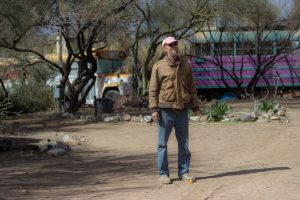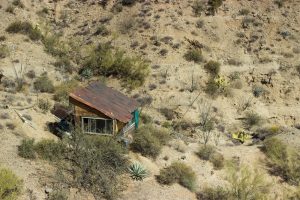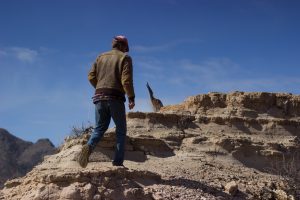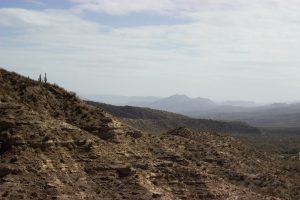By GABRIEL SANDLER
Cronkite News
GLOBE – The residents of Wind Spirit live on 16 acres surrounded by citrus and olive trees, stony hills and played-out mines. They’ve built their homes from materials ranging from a dirt-straw concrete mix called cob to canvas teepees to buses painted blue, purple and yellow. Outdoor sinks have signs requesting visitors use tree-friendly soap. All the bathrooms have compost toilets.
Wind Spirit, tucked between Winkelman and Superior, just south of Tonto National Forest, is an “ecovillage,” where residents live by a public set of ever-changing guidelines for respecting each other and the land.
“It seems so much with the environmental movement that people are concerned about the environment, but they don’t want it impacting their lives because they’re used to these certain conveniences,” said Don Clark, who founded Wind Spirit with two friends.
“I want to live a lifestyle I can feel good about.”
Wind Spirit is one of many alternative communities throughout Arizona, often called intentional communities. Although their goals range from spiritual to musical, many focus on ecology and sustainability.
“Since last year, the volume of people inquiring has doubled,” Clark said. “A lot of people are saying they don’t like what’s going on, so they’re looking for alternatives.”
A recent storm had knocked out electrical power, shutting down Wind Spirit’s water pumps. Clark’s partner, Sarah Edelman, had to drive to Globe to get parts, but she hopes their solar panel project will change things in the next few months.
“We’ll never need to be on the grid for the well pump anymore, and that’s going to be great,” Edelman said.
Edelman is used to such challenges. She moved a year ago from another ecovillage outside Tucson called TerraSante Village.
“It’s community,” Edelman said. “Sharing resources, sharing infrastructure, buildings and food … everybody’s responsible. … It’s sometimes hard to find people that come ready-made like that.”
Communal living has a long history, but many ecovillages have increased their networking with a sense of urgency. Online resources, such as the Fellowship for Intentional Community and the Global Ecovillage Network, help with that effort.
Sky Blue is executive director of the 30-year-old Fellowship for Intentional Community, which provides informational materials and a global directory of communities, ranging from monasteries to neighborhoods that share tools and have monthly potlucks.
“Intentional community is the broad umbrella term,” Blue said. “There are different kinds of intentional communities, ecovillages being one of them. The values part is where the “intentional” in “intentional communities comes in.”
Blue lives in a secular, income-sharing community in Virginia. He thinks many outsiders cling to outdated stereotypes of hippie communes, even if the motivations are accessible.
For communities that identify as ecovillages, Blue sees “dimensions of sustainability: cultural, economic and ecological.”
“They’re very holistic in nature, bringing together all the different aspects of life and also addressing it,” he said. “They’re also essentially a response to a critical analysis of society.”
Bruce Scher opened TerraSante Village after reading a climate change article in “Scientific American.” He bought land southwest of Saguaro National Park and started building in 2005.
“I liked the idea of a space that wasn’t relegated to some gutter,” Scher said. “The kind of people who have been marginalized to a certain degree, either by economic circumstances, economic choice or wanting to live in an alternative way that isn’t all commercialized … none of that was my personal experience – a lot of people, that is their experience.”
TerraSante’s residents nicknamed it a “laboratory for sustainability.” It sits in the desert as a member of the Sacred Earth neighborhood, 160 acres of “meta community.”
Permanent and nonpermanent residents include business professionals, self-styled inventors, native-seed vendors, seasonal campers and, once, a group of traveling hippies interested solely in repairing bicycles.
The Krieters recently moved to TerraSante from Harmony and Health, a community across the road. Leo and Amy Krieter, their son Timothy, 5, and Amy’s daughter, Reana, live in an enormous Army tent pitched atop wooden construction palettes, more of which will eventually become walls and additions.
“Our long-term goal is to be able to set up solar panels, be independent, be able to pick this up, take it down wherever we want, whenever we want,” Leo Krieter said.
“My family and I, we’ve been looking for a calmer way, a better way. When we first started living in the community, I was way overweight, way unhealthy, still dealing with military experiences.”
Krieter credits TerraSante with helping him lose weight, helping his wife quit smoking and giving his kids a place to live “free without judgment.” A recent arrival, Jason Romanowski, 32, has been babysitting Timothy and living in a tent the Krieters loaned him. Reana attends high school nearby, which requires a drive to the bus stop and an hour-long bus ride.
The Krieters’ reuse of materials for their new home aligns with other TerraSante projects. Plastic tubs are cut and repurposed for funnel gardening. Metal pipes are tuned for experimental music, or windmill development. One resident collects and sells native seeds from the surrounding desert.
In Arizona, California, Colorado and New Mexico, the Fellowship for Intentional Community lists 68 ecovillages, with even more across the country and internationally. Some only have one or two members as they begin to form. One in Paonia, Colorado, is meant for the elderly.
The Community for Mindful Living, based in Berkeley, California, coordinates projects nationally and internationally. For ecological values, the residents, “strive to live more sustainably by embracing permaculture principles … treading lightly on our planet.”
The ecovillage label often gets paired with other descriptions, such as cohousing, communes, spiritual community or coliving.
Beth Ann Morrison is a Ph.D. student at Arizona State University’s School of Sustainability. At the Happiness and Sustainability Lab, she and her colleagues examine how urban neighborhoods and people in general can increase quality of life through sustainability.
“(Ecovillages) are experimental,” Morrison said. “I love to see people exploring what new possibilities are there, maybe not new but alternative. The critique I have for doing things outside the city is that while it’s good for demonstrating what can be done … it doesn’t question the status quo. I kind of call those gated communities, even if they don’t look the same as what comes to mind with that term.”
Morrison sees problems with land ownership, indigenous cultural appropriation, lack of diversity and the attitude that many equate sustainability with sacrifice. In her mind, climate change isn’t an “oncoming catastrophe,” just a reality to which “people will have to adapt.”
Some Arizona ecovillages experiment with sustainable practices, but Morrison said living differently does not always mean making a difference.
“To go off into the middle of nowhere and remove yourself from larger society,” she said, “when you do have privileges and access to resources that you could otherwise be mobilizing. … Unless you’re doing something on a deeper level or a broader level, it’s a sheltered environment, it’s very private.”
For Morrison, unsustainability stems from inequality. She prioritizes collaborative designs, community building and resource sharing in neighborhoods as a more impactful way to address the problems that inspired TerraSante, Wind Spirit and others.
“Then you can start creating together, and envisioning new amazing things, like the ecovillage,” Morrison said. “Then gather the resources you need to start to make it.”
Even with the limitations and challenges of a rural ecovillage, however, Scher and Clark believe their sustainability models are doable.
TerraSante and Wind Spirit develop innovative food systems. At TerraSante, Scher experiments with “fortress gardening,” essentially fenced gardening that helps him protect their food from pests and weather.
“One of my fun projects was to try and create all the ingredients for summer salsa growing in the garden,” Scher said. “It was a challenge because cilantro is so hard to grow in the summer.”
Wind Spirit can grow a wider variety of food compared with TerraSante Village’s desert surroundings. In addition to its citrus and olives, the community has several chicken coops, each with a protected feeder that the chickens have learned to open but sparrows can’t.
Breezy Wilson lives in a cob house at the top of a ridge in Wind Spirit and uses a solar dehydrator to turn orange slices into “citrus chips.” She and her partner took on cooking for the community, specializing in vegan diets.
“Lots of veggies and fruits and nuts and seeds, and I try to put a lot of high protein foods out there without there being meat involved,” Wilson said. “Chia seeds, flax seeds, pumpkin seeds, sunflower seeds. … We go to Tucson and go to Sprouts or Natural Grocers for whatever the land doesn’t provide.”
Many residents of TerraSante and Wind Spirit worry that mainstream living habits will not last, and their sustainable practices will become essential.
Parts of the United States have already dealt with this reality. The “New York Times” reported on Louisiana residents who will abandon a coastal town because of climate change. A research paper submitted to Elementa predicts that 4 and 13 million people in the United States will be exposed to rising seas by 2100.
In the near future, Scher predicts, “similar environments that are going to be sprouting up all over the world as the climate changes. People are going to be on the run, they’re going to be refugees.
“If you look at what the scientists are saying and the data says, we’re heading for that scenario of really difficult habitation on planet Earth. We’re getting a jump on that, creating a space where we’re going to start looking at this stuff. How do we live in a marginal environment?”
This story is part of Elemental: Covering Sustainability, a new multimedia collaboration between Cronkite News, Arizona PBS, KJZZ, KPCC, Rocky Mountain PBS and PBS SoCal. For more stories from Cronkite News, visit cronkitenews.azpbs.org.
^_=
